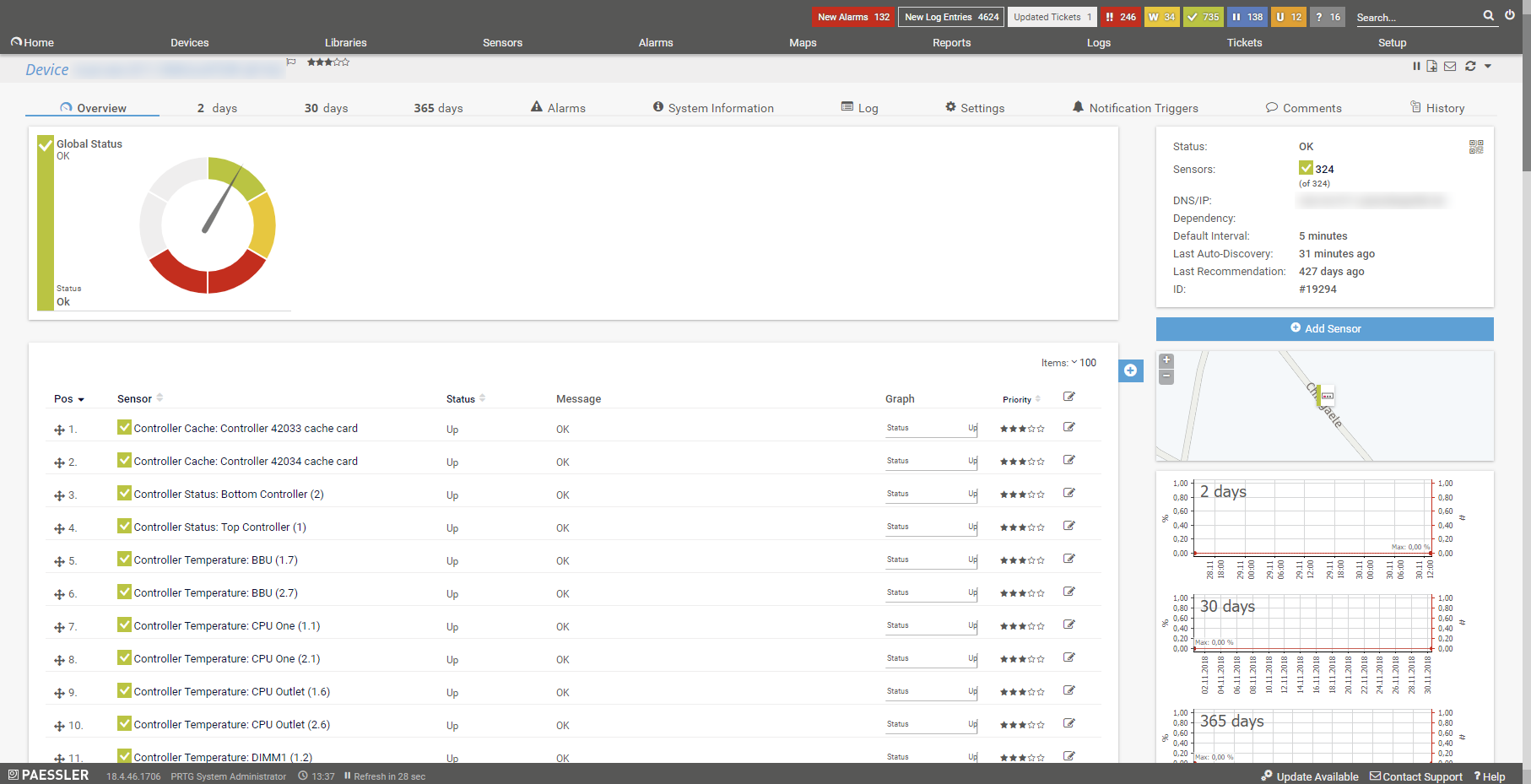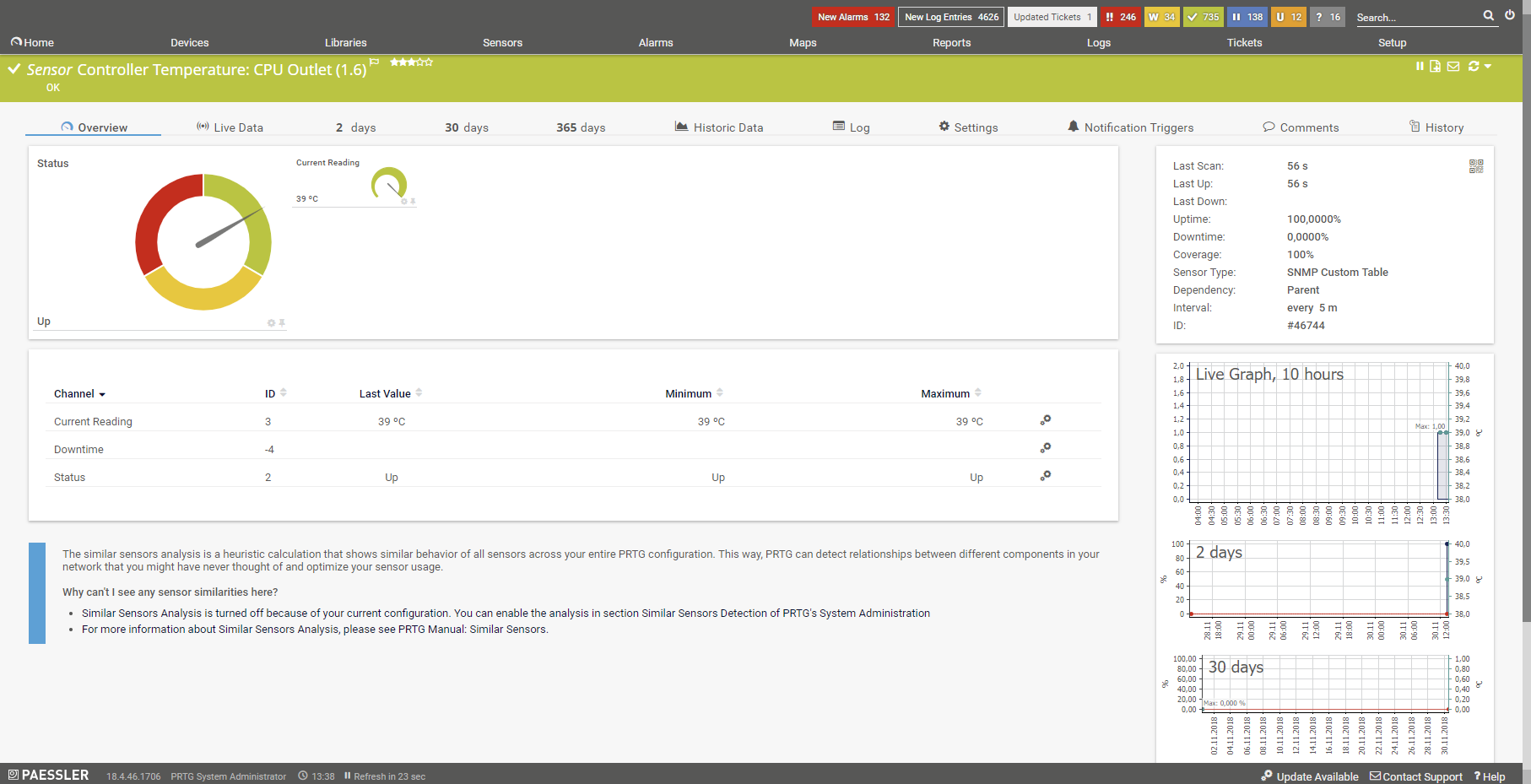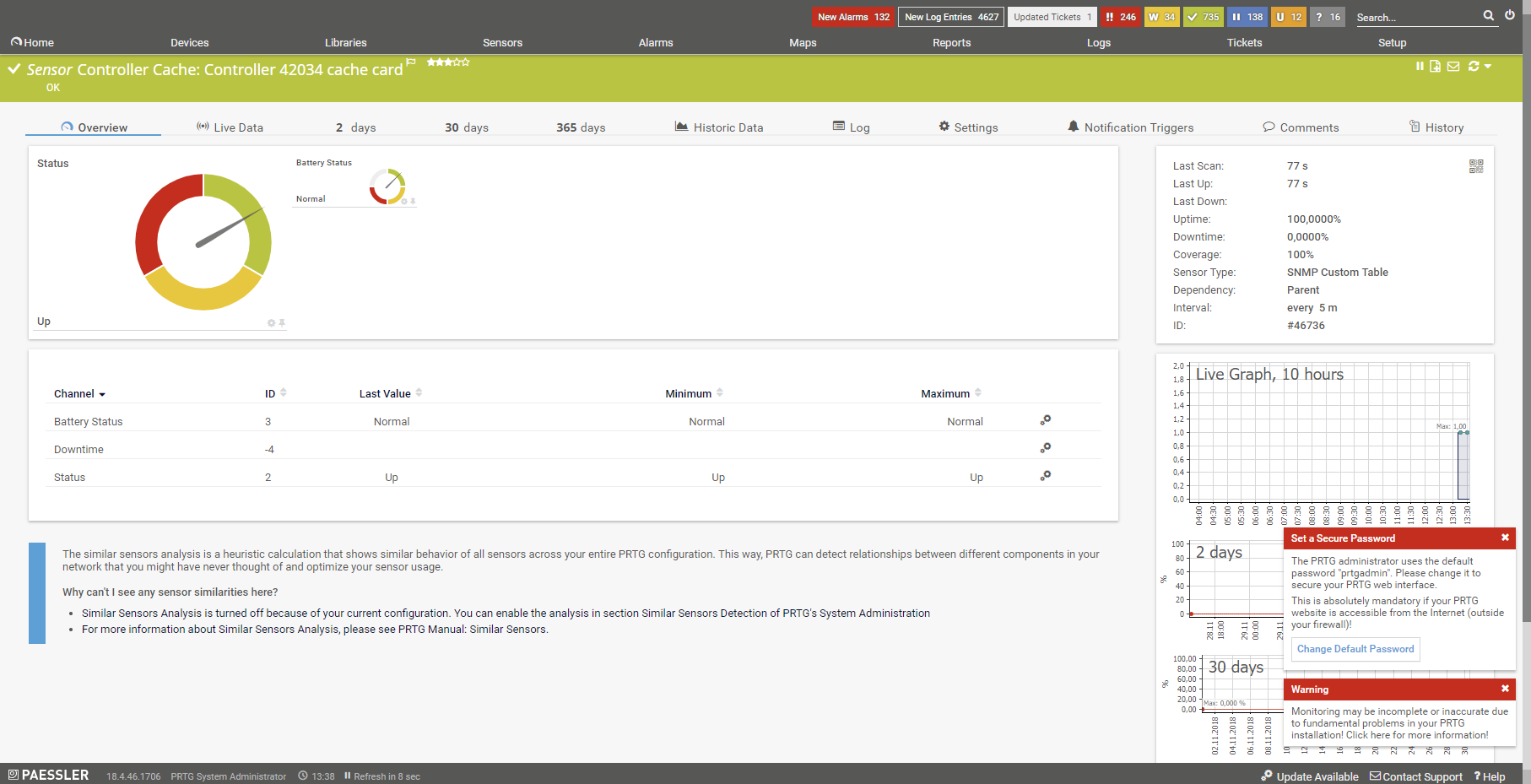This article applies to PRTG Network Monitor 16.3.25 or later
Monitoring Dell Compellent and other Dell Storage Systems
While we have some built-in sensors that may work with Dell's Storages, you might be looking for additional metrics/sensors.
We've put together a couple of lookups and a device template, which can be used to automate the deployment of these sensors using auto-discovery.
Adding Custom Sensors using the Auto-Discovery + Template
You can use the device template that we provide below to automatically create custom sensors with the PRTG auto-discovery.
The metrics that are available can vary. The sensors can monitor the following if the data is available:
- Controller Cache Card
- Controller
- Controller Temperature
- Logical Disk (Volume)
- Physical Disk
- Enclosure Status
- Enclosure Temperature
- Global Status
- Storage Center Status
- Storage Folder
- Free Space
- Total Space
- Used Space
The device template creates the available and compatible sensors based on the data at hand. The sensors implement default alerts whenever possible, but you can still fine-tune most channels by defining additional limits in the sensor channels settings or modifying the lookups included with the template.
Requirements
- PRTG Network Monitor 16.3.25 or later
- Because the device template relies on the auto-discovery process, the device you want to monitor needs to be reachable via PING.
- SNMP must be enabled on the device and the device must support the DELL-STORAGE-SC-MIB from where the data comes from.
- The device template is expected to be compatible with the following devices:
- Dell Compellent SC4020 with Dell Storage Center OS (SCOS) version 7.2.31
- Dell Compellent Series 40
- Dell Storage SC5020
- Dell Storage SC5020F
- Dell Storage SC7020
- Dell Storage SC7020F
- Dell Storage SC8000
- Dell Storage SC9000
- Dell Storage SCv2000
- Dell Storage SCv2020
- Dell Storage SCv2080
- Dell Storage SCv3000
- Dell Storage SCv3020
Known Issues and Limitations
- Depending on the amount of Logical Disks configured on your Storage you may see a very large number of sensors (one per Logical Disk). It is recommended to increase the scanning interval to at least 5 minutes in this case to avoid excessive SNMP queries.
- The temperature sensors may cause issues in some Firmware/Software versions. Feel free to follow-up if you encounter unexpected errors so that we may investigate.
- You may get a "Storage Folder: Unassigned" sensor throwing errors by default: "0 GByte (Free Space) is below the error limit of 10 GByte in Free Space" - This sensor can be paused/deleted.
- Some of the sensors (where a number like (1) or (1.1) is present in the name) are index-based, this means that if the device reboots or is updated the indexes *may* change. If this happens the sensors may become unreliable. If device is updated or rebooted it's advisable to delete these sensors and re-run the auto-discovery afterwards to be safe. The sensors will then be re-created and use the correct/appropriate index.
- PRTG shows some of the alerts as reported by the monitored device via SNMP using Lookups. If the status is not reported correctly via SNMP, PRTG cannot detect any issues. For additional alerts, please set up limits for additional channels.
- This device template was created based on data collected from other customers, so we cannot guarantee that the sensors described above will work on your systems or that the default thresholds are optimal for your use case. Use these components at your own risk. Please test and validate the sensors in your environment after deploying them.
Deployment and Usage
- Download the required zip archive containing the template's files here.
- Extract the archive to your PRTG program directory. By default, this is %ProgramFiles(x86)%\PRTG Network Monitor\.
- In PRTG, restart the core server: open Setup | System Administration | Administrative Tools | Restart Core Server and click Go!. This ensures that the MIB and lookups are loaded before you run the auto-discovery.
- Create a new device in PRTG with the address (IP or FQDN) of the device that you want to monitor and configure the SNMP credentials accordingly.
- Right-click your new device, select Run Auto Discovery with Template, browse for Dell Storage and select the Custom Dell Storage v0.x template from the list.
Note: Using the auto-discovery with a dedicated device template is convenient here because it automates the creation of the custom sensors in an organized fashion.
- The sensors are deployed after a couple of seconds.
- You can adjust the channel limits or lookups to your needs later.
Result
The resulting sensors will look like this:
Sensor's Overview
Device Overview
 Right-click and select Open Image in New Tab for full-screen view
Right-click and select Open Image in New Tab for full-screen view
Sensor Overviews
 Right-click and select Open Image in New Tab for full-screen view
Right-click and select Open Image in New Tab for full-screen view
 Right-click and select Open Image in New Tab for full-screen view
Right-click and select Open Image in New Tab for full-screen view
No sensors deployed? :(
Please read ahead for troubleshooting.
Troubleshooting
Have any issues? Please don't hesitate to contact us by replying to this post or via a support ticket. Please make sure to mention this KB post. Please read ahead for troubleshooting steps that you can take in advance.
Auto-Discovery Log
Your auto-discovery log tells you a lot about what went wrong during the sensor's deployment. You can troubleshoot the auto-discovery by inspecting the auto-discovery log. If you get entries like the one below (NOT FOUND), it means that the required protocol or Object Identifier (OID) is not available and the sensors can't be deployed.
[...]
21.08.2017 09:17:17: Template Loaded; Device ID: 22848; Name: Custom Dell Storage v0.3
21.08.2017 09:17:18: Template Check; Device ID: 22848; Check ID: ping; FOUND
21.08.2017 09:17:19: Template Check; Device ID: 22848; Check ID: snmp; FOUND
21.08.2017 09:17:20: Template Check; Device ID: 22848; Check ID: snmp_scCacheTable; NOT FOUND
[...]
In the example above, some sensors were skipped because the device did not respond to the snmp_scCacheTable check. This means that this data is probably not available on your device. You can track this data by looking for the name after snmp_. In this case, a search for scCacheTable will tell you what OID from what MIB is missing.
You can also use this log to identify if the discovery was interrupted because the device did not respond to PING or to a basic SNMP check.
SNMP Data
If the discovery log is not sufficient, you can review the SNMP data directly from your device. To do so, download this file and use it with the Scan Script option in our SNMP Tester. This will allow you to review which SNMP queries succeed and which do not deliver any data. Please have this information at hand when contacting our support team.
Version History
| Version | Description |
|---|
| 0.3 | First Public version/release |
| 0.4 | Added Storage Folders (Space Free/Usage metrics) |
Best Regards,
Luciano Lingnau [Paessler Support]
 Right-click and select Open Image in New Tab for full-screen view
Right-click and select Open Image in New Tab for full-screen view Right-click and select Open Image in New Tab for full-screen view
Right-click and select Open Image in New Tab for full-screen view Right-click and select Open Image in New Tab for full-screen view
Right-click and select Open Image in New Tab for full-screen view
Add comment